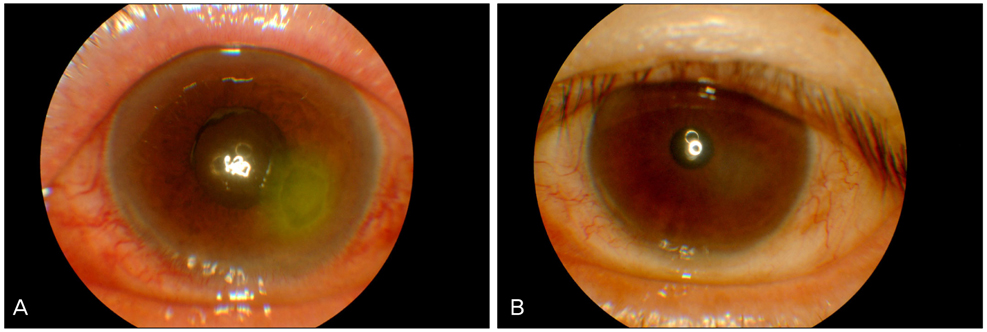Korean J Ophthalmol.
2011 Oct;25(5):349-351. 10.3341/kjo.2011.25.5.349.
A Case of Stenotrophomonas maltophilia Keratitis Effectively Treated with Moxifloxacin
- Affiliations
-
- 1Department of Ophthalmology, Sahm Yook Medical Center, Seoul, Korea. virgo901@hanmail.net
- KMID: 1098639
- DOI: http://doi.org/10.3341/kjo.2011.25.5.349
Abstract
- A 70-year-old man with a long history of diabetes mellitus presented to our hospital (Department of Ophthalmology, Sahm Yook Medical Center, Seoul, Korea) complaining of severe ocular pain and visual disturbance in his left eye that had started three days prior to admission. A round 3.7 x 5.0 mm dense central stromal infiltrate with an overlying epithelial defect was noted on slit-lamp examination. Following corneal scrapings and culture, topical 0.5% moxifloxacin and 0.5% tobramycin were administered hourly. A few days later, Stenotrophomonas maltophilia was isolated in a bacterial culture from a corneal specimen. According to the results of susceptibility tests, topical 0.5% moxifloxacin was given every hour and 0.5% tobramycin was stopped. The patient's clinical features improved steadily with treatment. The corneal epithelium healed rapidly, and the infiltrate resolved within four weeks of the initiation of treatment. The patient's best corrected visual acuity improved from hand motion to 20 / 25.
MeSH Terms
-
Aged
Anti-Infective Agents/administration & dosage
Aza Compounds/*administration & dosage
Cornea/*microbiology/pathology
Diagnosis, Differential
Eye Infections, Bacterial/diagnosis/*drug therapy/microbiology
Follow-Up Studies
Gram-Negative Bacterial Infections/diagnosis/*drug therapy/microbiology
Humans
Keratitis/diagnosis/*drug therapy/microbiology
Male
Ophthalmic Solutions
Quinolines/*administration & dosage
Stenotrophomonas maltophilia/*isolation & purification
Visual Acuity
Figure
Reference
-
1. Khardori N, Elting L, Wong E, et al. Nosocomial infections due to Xanthomonas maltophilia (Pseudomonas maltophilia) in patients with cancer. Rev Infect Dis. 1990. 12:997–1003.2. Spencer RC. The emergence of epidemic, multiple-antibiotic-resistant Stenotrophomonas (Xanthomonas) maltophilia and Burkholderia (Pseudomonas) cepacia. J Hosp Infect. 1995. 30:Suppl. 453–464.3. Zuravleff JJ, Yu VL. Infections caused by Pseudomonas maltophilia with emphasis on bacteremia: case reports and a review of the literature. Rev Infect Dis. 1982. 4:1236–1246.4. You IC, Lee SH, Park YG, Yoon KC. Clinical aspect and prognosis of stenotrophomonas (Xanthomonas) maltophilia keratitis. J Korean Ophthalmol Soc. 2007. 48:889–897.5. Palleroni NJ, Bradbury JF. Stenotrophomonas, a new bacterial genus for Xanthomonas maltophilia (Hugh 1980) Swings et al. 1983. Int J Syst Bacteriol. 1993. 43:606–609.6. Senol E. Stenotrophomonas maltophilia: the significance and role as a nosocomial pathogen. J Hosp Infect. 2004. 57:1–7.7. Bottone EJ, Madayag RM, Qureshi MN. Acanthamoeba keratitis: synergy between amebic and bacterial cocontaminants in contact lens care systems as a prelude to infection. J Clin Microbiol. 1992. 30:2447–2450.8. Chen YF, Chung PC, Hsiao CH. Stenotrophomonas maltophilia keratitis and scleritis. Chang Gung Med J. 2005. 28:142–150.9. Bauernfeind A. Comparison of the antibacterial activities of the quinolones Bay 12-8039, gatifloxacin (AM 1155), trovafloxacin, clinafloxacin, levofloxacin and ciprofloxacin. J Antimicrob Chemother. 1997. 40:639–651.10. Mather R, Karenchak LM, Romanowski EG, Kowalski RP. Fourth generation fluoroquinolones: new weapons in the arsenal of ophthalmic antibiotics. Am J Ophthalmol. 2002. 133:463–466.
- Full Text Links
- Actions
-
Cited
- CITED
-
- Close
- Share
- Similar articles
-
- A Case of Corneal Ulcer Caused by Combined Infection of Stenotrophomonas Maltophilia and Aspergillus Fumigatus
- Clinical Aspect and Prognosis of Stenotrophomonas (Xanthomonas) Maltophilia Keratitis
- Localized Cutaneous Infection due to Stenotrophomonas maltophilia in Immunocompetent Patient
- A Case of Corneal Ulcer Caused by Stenotrophomonas maltophilia in a Healthy Patient
- Antimicrobial Susceptibility of Stenotrophomonas maltophilia Isolates from a Korean Tertiary Care Hospital


